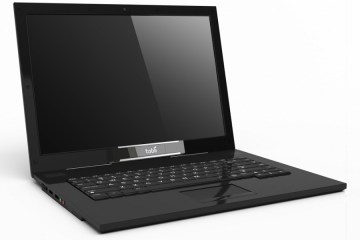There was a time when the mouse and keyboard were the two primary ways to interact with a computer. Then came touch screens, and the idea of “natural input” became all the rage.
Our eyes and the space around us may be the next big innovations on that front. For the past few years, a handful of companies have been working on eye-tracking and gesture control for computers. Now, there are signs that these natural input methods are almost ready for prime time.
Here’s one recent example: Leap Motion, the maker of a small, upcoming motion controller for Windows and Mac computers, announced this week that its hardware will be bundled with select PCs from Asus. Later this year, Asus will start embedding the technology directly into high-end notebooks and all-in-one PCs. (A standalone version of Leap Motion, which costs $70, is shipping soon.)
Leap’s sensor is roughly the size of an iPod, and it creates a space of eight cubic feet for recognizing hand and finger gestures. Leap expects its technology to be useful in 3D modeling and artwork, mid-air handwriting, gaming or just pinching and zooming on web pages. The company is releasing tools so developers can make their apps work with the device.
Although Leap isn’t alone in working on gesture control for PCs, it seems to be the furthest along in bringing the technology to the masses. The device is much less expensive than the PC version of Microsoft‘s Kinect motion controller, which sells for $250, and though its detection range is smaller, it’s more accurate, tracking movement down to 1/100th of a millimeter. Leap also has competition from Elliptic Labs, which has developed radar-like gesture software for Windows 8 devices, but it’ll be up to hardware makers to integrate Elliptic’s technology. According to Engadget, that may not happen for another year or so.

As for eye-tracking, Sweden-based Tobii announced this week that it will ship its first device for the consumer market this fall. The Tobii Rex is more of a supplement to the mouse and keyboard than an outright replacement. For instance, instead of clicking on each text box on a web page, users can just look at the desired text field and start typing. To switch between programs, users can press a keyboard shortcut to show all their open windows, then press it again while looking at the window they want to maximize. (I first tried this technology a year ago, and was impressed by how accurate it was.)
Tobii’s technology has longer to go until it’s ready for the mainstream. The company will only sell 5,000 Rex units by this fall, and hasn’t announced a price, but an early developer edition will cost $995. Still, the price is likely to fall over time, and eventually the technology could be embedded in PCs, much like Asus plans to do with Leap Motion.
The future is still murky for these technologies. Microsoft could always spoil Leap Motion’s ascent with a better version of Kinect that could be embedded within future PCs and tablets. Any one of these smaller companies could be acquired by a tech titan like Apple or Google, and have its plans changed. In all cases, the success of these input methods depends on whether app developers embrace them — a shaky proposition when they’re not baked directly into the platforms they run on. Still, the launch of actual consumer-facing products is a good start.
I’ll be demoing some of these products next week at the Consumer Electronics Show, and will report back on how it goes.

